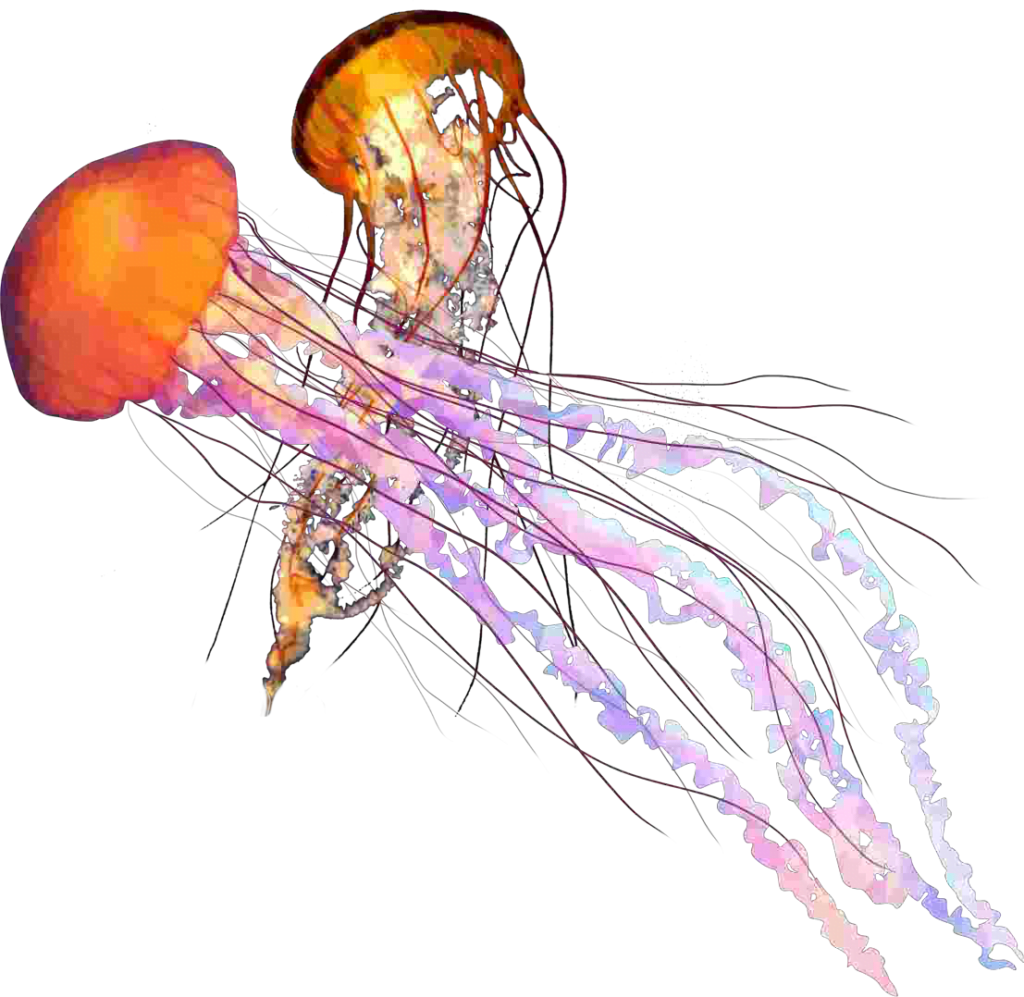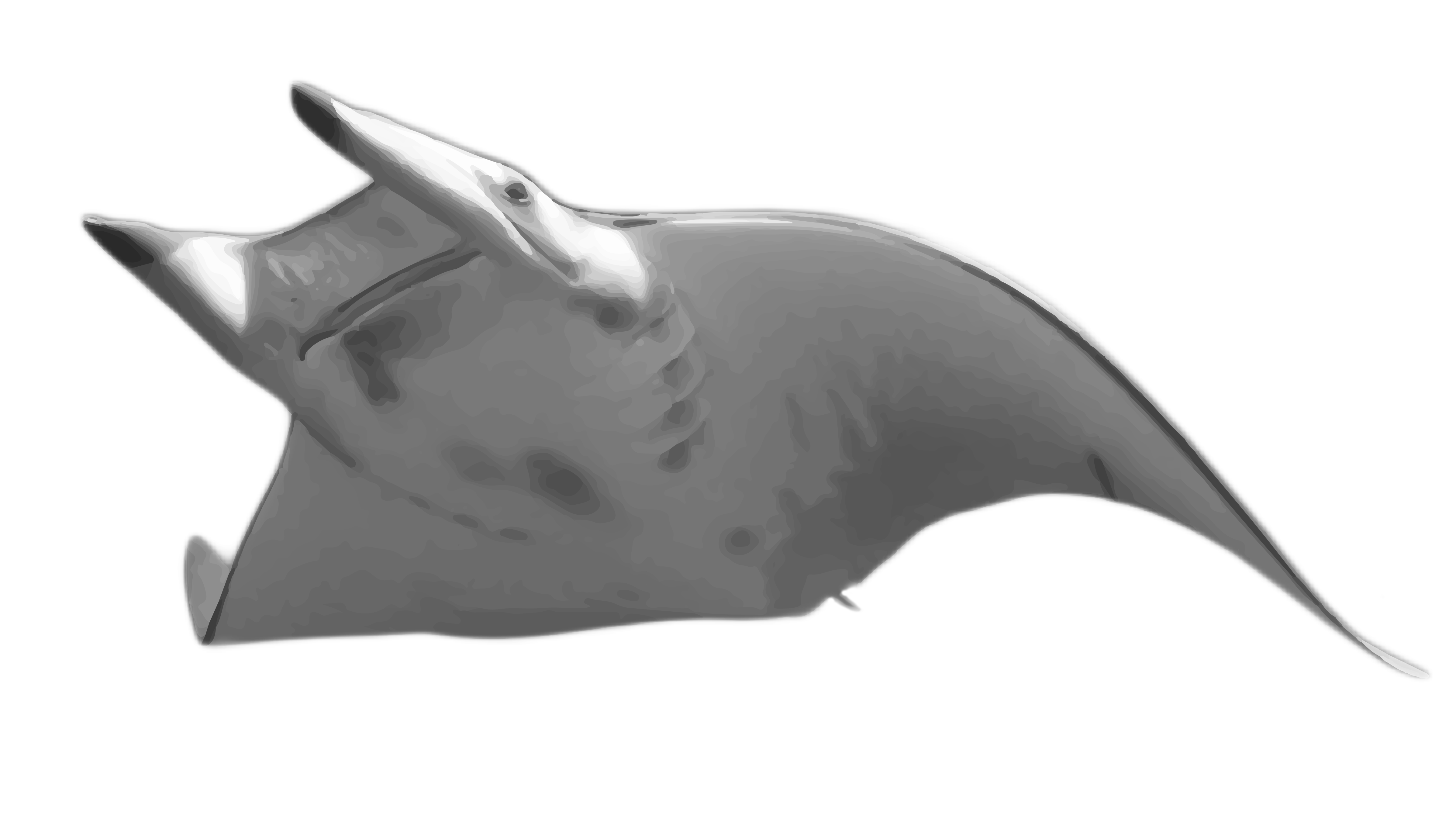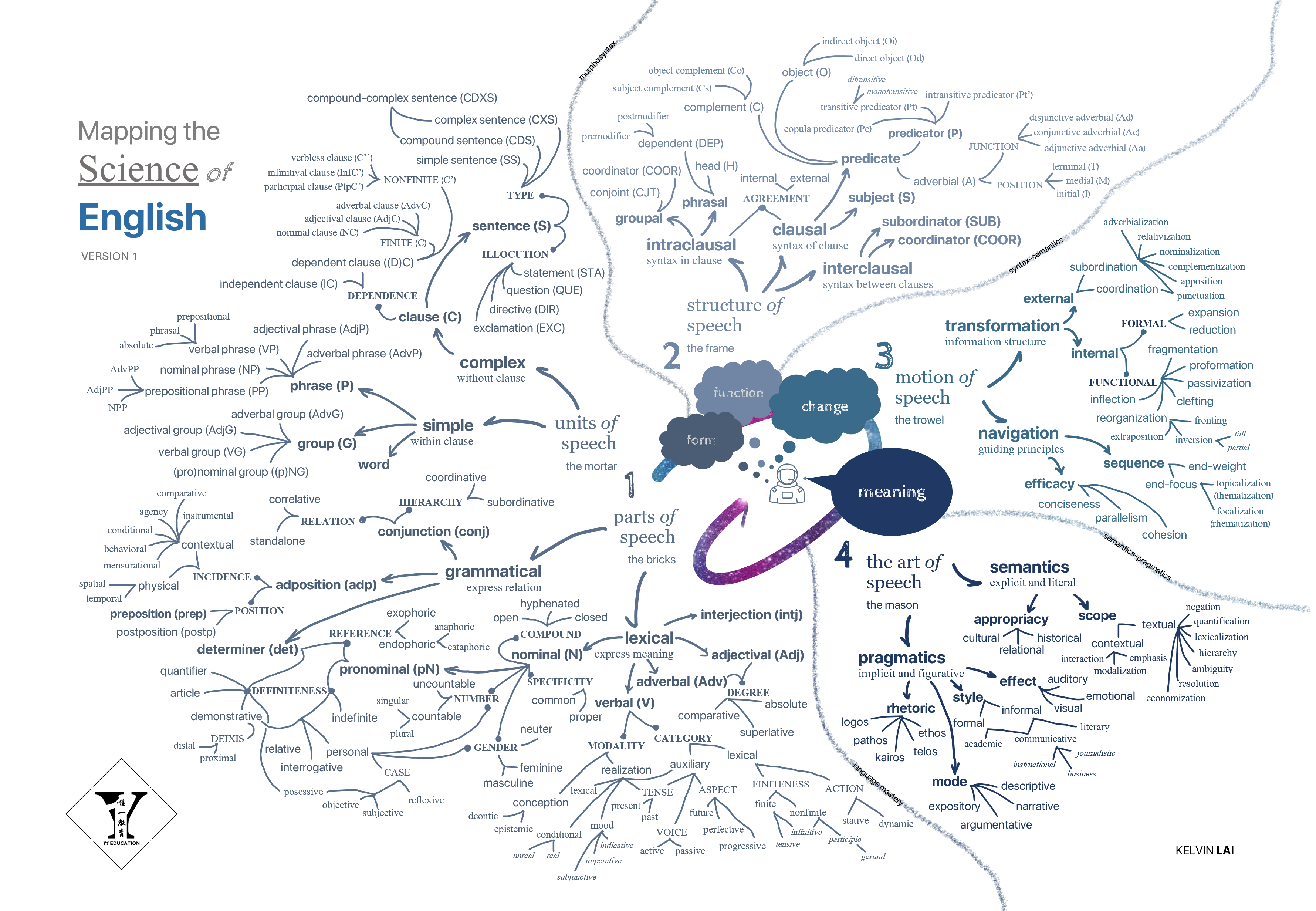

English Masterclass
Own the world’s language the logical way—the way of the master.
EM1
The Science
of English
Grammar, effective grammar that is, is above all about optimizing WEIGHT and FLOW, the two components of information structure. Together, the right weight and the right flow give rise to effective communication. But that’s art, which has first to begin with science, with which a thorough understanding of grammar can first be established, an intuitive knowledge of how the English language is to be modeled.

The ingredients that form a language, types of information if you will, come in all shapes and sizes. In general, the study of how information appears, how it looks like, is the study of FORM.
First, we have the unit of speech (UoS): WORD, GROUP, PHRASE, CLAUSE, SENTENCE — in essence, how dense (or weighty) an information package is. Secondly, we have the part of speech (PoS): NOUNS, VERBS, ADJECTIVES, CONJUNCTIONS, etc.— the role that information plays in any given unit of speech. Together, the UoS and the PoS of any piece of information express the formal identity of that information, e.g. a PHRASE (P) that plays the role of a NOUN (N) forms a noun phrase (NP).
Next, we need to know in what order a couple of these packets of information should be arranged so that it is considered grammatical. Here, we enter the realm of FUNCTION.
5 of the 10 functions we will study over this course are worth an introduction here, as these are to the accuracy and style of a sentence what croissant is to French culture. At its simplest, a sentence comprises a SUBJECT (S), always a unit of noun, and a PREDICATOR (P), always a unit of verb. Without any of these, and especially the predicator, there would be no such thing as a sentence.
P, which describes S, defines the predicate. If P is transitive, it describes S as performing an action on an OBJECT (O), resulting in the sentence order (syntax) S-P-O, such as “He ate a leaf.” In contrast, if P is copula, it describes S as being equal to a COMPLEMENT (C), thus the syntax S-P-C, such as “He is happy.” While O and C perform predicative functions, ADVERBIALS (A) behave differently in describing P directly and can therefore be used indefinitely.
EM2
The Art
of English
A writer is creative, not only because the mind is rid of the burden of having to constantly look out for and reconcile with errors, but also because the mind has gained the ability to reason with the rules of engagement, such that it can generate structures beyond what is considered standard.
At this stage, you’re no longer just using the language, but you’re also inventing new structures, new ways of expressing meanings, of revealing information, and perhaps more importantly, you’re having fun with the language. In short, you’ve become not just an English user, but a superuser.

A steady grasp of FORM and FUNCTION—the SCIENCE of English—enables one to write an accurate sentence, for example: “Andy’s mind went completely blank, lips utterly sealed, feet taped onto the stage floor, frozen before the microphone.“
But that’s not enough if you’re looking to also write a stylish sentence, which can partly be achieved by grammatical means, i.e. syntactically, by tweaking the structure—the weight and flow of information. The same sentence may be rewritten, and thus upgraded, as: “It went completely blank, Andy’s mind, before the microphone his lips utterly sealed, onto the stage floor his feet taped, frozen.“
Style, of course, goes beyond information structure. It can also be effected (no, Grammarly, not “affected”) by semantic means, i.e. lexically, by tweaking not the structure but the information itself, the meaning of it.
It goes without saying that this ultimately boils down to the range and depth of vocabulary, though as with any art form, the artistic use of language has as much to do with science as it has with art. Meanings, in short, can be categorized, and they can be organized. Approaching the field of semantics as would a pro surfer reading the tides conditions us to be more conscious in deliberating what to write and what to say.
Having completed this stage, one may rewrite our example sentence as: “It went pitch black, what little remained of Andy’s mind, his lips, fidgety before the solitary mic, utterly sealed, and his feet, taped onto the stage floor, like quicksand, firmly welded, forever frozen.“
Gain native proficiency in under two years.
Hail, Grammar.
To acquire native proficiency is to establish a scientific framework of the English language firmly in your mental muscle, not an incomplete hunch, but deep-seated knowledge that makes it possible for you to internalize and command its structure, and to become more conscious, more appreciative of its process as a craft: the optimization of informational weight and flow.
An added perk here is that you also get to be quite good at editing, proofreading, and paraphrasing—in general great at picking up errors, though we imagine your friends probably won’t like that very much.
Linguists, best party guests since the last Ice Age.
Hands down, linguists have the coolest job, getting all nerdy and picky about language, that thing the rest of us treat as we do breathing, or walking—it’s just a thing we humans do, so what’s the fuss about it? Well, for one there’s no being creative with breathing and walking, unlike which, language shapes history as we know it—to possibly misinterpret Molière: “Grammar, which controls even kings.”
What, after all, could be more fascinating to man than the seed of his society, that which still evolves as he lives and speaks?
There are no such things as Rules in a human construct.
The extent to which we instruct English grammar, with a much greater scope and depth, is such that you will be able to reason with them, and even transcend them—what the best storytellers and poets do.
This is why language, like all human constructs, e.g. the economy that bases our lives, the politics that enshrines our values, evolves, in space and in time. Once you see language for its historical fluidity, you begin to invent.
Help! It takes forever to write.
What more could we say, other than congratulate you from the bottom of our hearts?
For this is exactly the stage we wish to bring all our students to, one where that “MY WRITING” folder of yours keeps piling up with incomplete drafts of this fantasy story and that persuasive article you’d perhaps wanted published—but above all else where you constantly experiment and push yourself, all out of your own volition, because you simply couldn’t help it; you’ve fallen in love with the language.
Road to mastery, explained with an iceberg.
This analogy allows us to see plainly just what mainstream education is really trying to “accomplish”, an actual miracle, but in a truly futile fashion. They try to bring you from the tip all the way to the bottom, effectively bypassing almost entirely the two absolutely crucial stages in between. We couldn’t put it better than Einstein did: “The definition of insanity is doing the same thing over and over again, but expecting different results.”
It’s like trying to sprint in a 100-meter race, against Usain Bolt no less, when you have the stamina of a panda, and with a pair of beach sandals. “Explore them yourselves, and have fun,” they say. “Forget the years you’ll eventually have to spend searching your way in the dark, stumbling upon dead end after dead end in the process. And should you survive the process intact, you’ll probably be as old as we are, if not more.”
Level One
That which is bare above sea, it’s dreadful, it’s a lot of repeated practice, and boy, will there be plenty of rules to get used to.
Basic Form & Function
You begin by picking up on one rule after another that cannot quite be understood and reasoned with—not yet, anyway. Here, the rules control the user, not vice versa.
Level Two
That which is right beneath the surface, where the sun still shines, where you go from worrying about making mistakes to realizing how unchanging and predictable your sentences are.
Advanced Form & Function
Right beneath the surface, where the sun still shines, you advance your knowledge of forms and especially functions to complete the rest of the puzzle. By the end of this level, you will have gained the ability to use all the building blocks of English accurately, but not necessarily stylistically.
Level Three
That which most, admittedly even native speakers, do not reach, where you transition from science to art, from being an accurate user to being also a stylistic user.
Transformation
Fortunately, the limitation of variability in your sentence structures is overcome at this level. Here, the focus is to optimize the weight and flow of information to render certain effects.
Level Four
That which extends all the way toward the bottom tip of the iceberg, where you transcend grammar entirely. Here, things get really fun.
Meaning
Here, you apply grammar with purpose, infusing structure with meaning, what linguists call semantics (the meaning of the text itself) and pragmatics (the meaning in context). You will learn how grammar and vocabulary can be used in tandem to elicit specific effects, whatever the purpose—anything a grammatical mind can conjure, anything a true artist can execute.
Don't just write. Design.
Our grammar-first approach makes you more conscious of the process by which information is composed so that you go from typing to crafting. To illustrate this workflow, consider combining the six simple—choppy!—sentences below into a complex sentence.
- The sun retreated from the sky.
- It dipped its chin into the earth.
- It was resplendent.
- Its hues burst into a flash across the sky.
- It then cast its rays upon the sea.
- The water was still and tranquil.
- It awaited nightfall.
Step 1A / FM
Formation
Begin by selecting the main clause, relative to which the form of other information should be decided. In our example, we assign the main clause to the first sentence:
#1 > MAIN clause: the sun retreated from the sky
#3 > “sun” >> verb-less clause: resplendent
#4 > “heavens” >> relative clause: across which its hues burst into a flash
#2 > “projected” >> adverbial clause: as it dipped its chin into the earth
#5 > “sun” >> prepositional phrase: before casting its rays upon the sea
#6A > “sea” >> relative clause: whose water remained still and tranquil
#6B > “water” >> participial clause: awaiting nightfall


Step 1B / PG
Progression
Put all the pieces together in such a flow that information unravels in a way that you fully intend for your reader to experience the text. In our example, we use the following sequence:
Order = { #1- #3 -#1 #4 #2 #5 #6A #6B }
The sun, resplendent, retreated from the sky, across which its hues burst into a flash as it dipped its chin into the earth, before casting its rays upon the sea, whose water remained still and tranquil, awaiting nightfall.


Step 2 / TF
Transformation
Consider applying transformations to fix any structural issues such as ambiguity, improve readability, or elicit poetic effects such as parallelism. Among many such transformations, in the same but very different example below does one note the coordinated use of inversion, extraposition, postposing, and reduction:
Where the sun retreated, its chin dipping into the earth, into a flash burst its hues across it, the sky, resplendent, its rays cast upon the sea, the water, awaiting nightfall, still and tranquil.


Step 3 / LX
Lexicalization
Upgrade your vocabulary to be more detailed and evocative of whatever you want in your reader’s head—or heart. As a final touch-up to our example, we attempt three enhancements: (1) employ figurative language, (2) paraphrase using synonyms, (3) develop a rhetorical element, and (4) devise a sound scheme:
Where the sun withdrew, its mighty forehead dipping into the cold blue earth, into a blinding flash burst its golden flame across it, the full expanse of the sky, from horizon to heaven, dazzlingly resplendent, its retreating rays, hues of amber through its final tint, cast upon the immortal sea, now aglow in the crimson shadow, then a sable glitter, the water, meanwhile, awaiting the fall of night, in awe, in peace, still as a mirror.
Visit our eLibrary for the best learning resources and guides.
Read Our Latest on #English
The Ultimate Map of English
Your entire learning journey with us in one diagram






